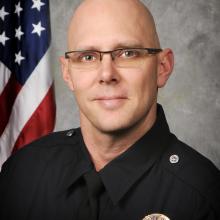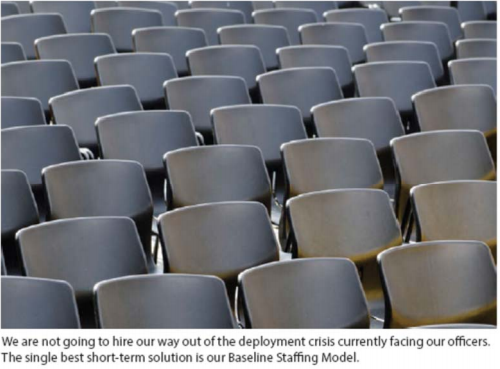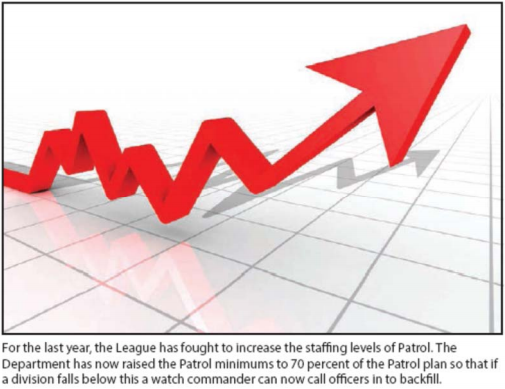Title
Straight Talk - April 2017

Body
Over the last year, my intention with each article has been to introduce, promote or critique topics in a unique and thought-provoking way. I strive to be measured and reasoned in my approach and avoid subjective emotional rhetoric. Up to this point, I have avoided writing an article that was purely a membership update. Well, I guess there is a first time for everything. There has been a recent increase to the patrol minimums by Chief Moore, from 50 to 70 percent of the patrol plan before officers can be called in. I want to bring everyone up to speed on what it took to get here.

On Tuesday, March 7, I addressed our delegate corps and told them that, along with military veteran issues, there is nothing more important to me than bolstering our Patrol staffing levels. Before I go into the background of this issue let me clarify just a couple things. I am not insinuating that the rest of the membership is not important to me, or that I am not actively working on other issues. I am also not implying that staffing is not a critical issue for other units, sections and assignments. Our whole Department is understaffed. You know it. I know it. The Chief knows it.
On the issue of deployment, I chose the triage method. In a mass casualty incident, you may walk by, around or even over wounded people in order to treat the more severely wounded. Right now, Patrol is the most severely wounded. I believe you can tackle many issues with moderate success or you can excel at a few. With that in mind, in January of last year, we started a strategic plan to address the critically low staffing levels in Patrol.
Over a year ago, we held a press conference to shine a spotlight on the dangerously low deployment of Patrol units. The Chief’s reaction to this was to dismiss our concerns as retaliatory for his outspoken critique of an officer-involved shooting. A month later, the League and the Department were called before the Public Safety Committee to present our concerns and provide solutions. The Department’s presentation was reminiscent of the “Move along. Nothing to see here” mantra. On the other hand, the Board introduced our Community Policing Reset plan that introduced three real world solutions to deployment: an alternative dispute resolution plan to streamline our broken workers’ comp system, hiring of more civilians so that police officers could be free to do police work and a baseline staffing model so overtime funds could be used to backfill Patrol cars that go unfilled due to officers being sick, injured or on vacation.

While the Department and City leaders were supportive of overhauling the workers’ comp system and hiring more civilians, they were less than enthused at the prospect of paying overtime for baseline staffing. Nearly a month after the Public Safety Committee hearing, the residents of San Pedro, angered at the lack of Patrol resources in their neighborhoods, held a town hall style meeting. After a sustained and targeted media campaign stressing our depleted Patrol force, the Chief publicly admitted to the attendees that we need an additional 2,500 officers to be able to adequately and safely patrol Los Angeles. Let that sink in.
Forget the arbitrary number of 10,000 officers. It’s meaningless, especially considering our own Chief admitted we need to be at 12,500 sworn. The City and Department chose to hang their hat on recruitment and hiring as the solution to understaffing. However, we continued educating the public and City Councilmembers on the significant rise in crime throughout the city, and the insurmountable pressure we were putting on Patrol to do their job without the necessary resources. We stressed that hiring, while necessary, was a very long-term solution to the problem. We passionately argued that baseline staffing was the single best short-term solution to our staffing crisis.
Around October of 2016, Office of Operations established Patrol minimums for each division. These minimums were the breaker switch, that if triggered, would allow officers to be called in to backfill. Unfortunately, these minimums were set at 50 percent of what the Patrol plan called for. I’m just an army dog and never went to college, but if 100 percent of Patrol plan is an “A,” then 50 percent of it is an “F.”
As we pushed our message forward, we gained the support of many City Councilmembers. Councilmember Mike Bonin even put forward a proposal to address the deployment issue that was similar to our own baseline staffing model. We even made what many would consider an unlikely ally on the issue with Cynthia McClain-Hill of the Police Commission. During some long conversations with her, we emphasized the impact inadequate Patrol staffing has on the morale of officers, community policing and officer safety. She was in complete agreement. Based on these discussions, she arranged a joint meeting with herself, Office of Operations and the League so we could have an honest conversation about Patrol staffing and reach some meaningful solutions.
Following that meeting, we met with Chief Moore and shared our concern that establishing the minimums at half of what the Patrol plan calls for is simply not good enough. I told him we are failing the officers we ask so much of. In that discussion, Chief Moore asked me what we
could do to increase the morale of Patrol. I replied in all seriousness, “Nothing will have a
greater impact on morale right now than giving our officers the resources they need to
do their job.”









